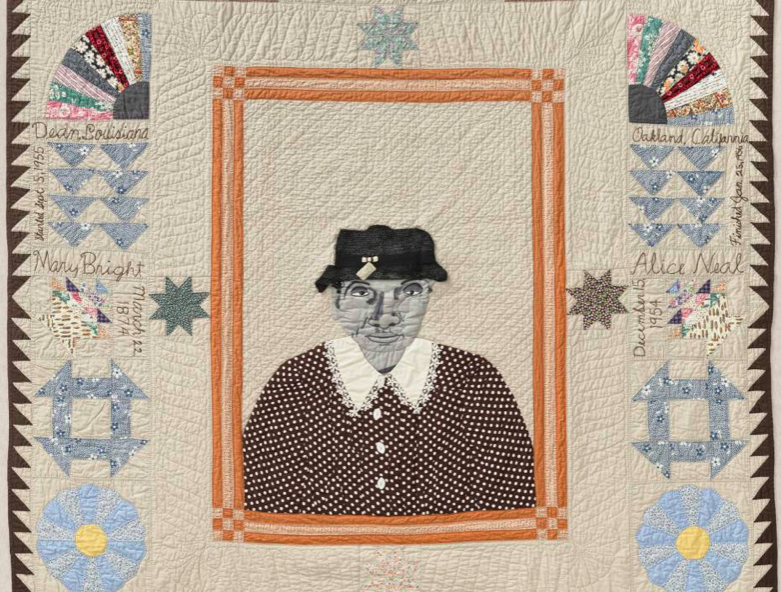Stitching Family
Routed West:
Twentieth-Century African American Quilts in California
Berkeley Art Museum / PFA
Ongoing – November 30
Eli Leon was an Emeryville psychologist and art collector. His particular interest was a truly specialized niche, African American quilts made by those making the journey West during the Second Great Migration and who chose to live in California. These quilts were made during that journey, or to commemorate the travel (and travail), or quilts made earlier by family members and considered too special to leave behind. When you consider that a million African Americans settled in the Golden State during the Second Great Migration, that’s still a lot of possible quilts. Leon was known to prowl flea markets throughout California looking for these original quilts. He managed to collect 3,000 of them.
While the Great Migration saw 2 million African Americans leave the rural South between 1910-1930 and settle in the North and Midwest, during the Second Great Migration (1940-1970), another four million African Americans sought greater opportunities and escape from the South’s more oppressively overt racial environment. The quilts became physical reminders of the homes they left behind.
Simultaneously, the quiltmaking skills that many migrants brought with them—frequently learned from mothers, grandmothers, and other kin—spurred the creation of a new wave of African American quiltmaking in the later part of the twentieth century, extending its roots into the Western United States, and specifically in California. These quilts explore the medium’s unique capacity for connecting kin across time and distance, holding memory and ancestral knowledge, and opening up space for beauty and artistic ingenuity.
Quilts, epically time-consuming manifestations of comfort and great care, can hold within them entire genealogies, lives remembered in stitches and bits of well-worn fabric. These quilts hang from walls and drape over supports like pages from a book. They are stories, told by hand through fabric choice, pattern arrangement and with painstaking attention to detail.
Currently, it’s common to see quilts hanging in museum spaces. They serve as geometric cousins of modernist abstractions, helping to warm up museum galleries. According to curator, Elaine Yau, quilting is an art practice that cannot be reduced to a conversation about form. Quiltmaking is a practice handed down through generations, oftentimes standing in as a permanent expression of the family tree. Thus, as a serious quilting exhibition, Routed West recenters the art historical narrative onto the quiltmakers and their lives. BAMPFA’s approach shows that clearly in the object labels, which often detail how an artist learned and deployed their craft, the source of their fabric and when a particular quilt entered Leon’s collection. In these labels are complex, rewarding narratives of distant cousins reconnecting in the Bay Area, and of those who quilted to provide for their families. Throughout the show, small samples of different quilting materials and patterns are provided as tactile aids next to the untouchable originals. BAMPFA’s acknowledgement of how difficult it is to not caress velvety corduroys or puffy checkerboards.
Alice Neal, ‘Mary Bright Commemorative Quilt (with Dresden Plate, Monkey Wrench, Wild Goose Chase, Fan, Basket of Flowers, Star of Lemoyne, Nine Patch blocks), 1955–1956. Also with a detachable hat. However, see note above – do NOT try to detach it!
Consisting of one hundred artworks representing nearly eighty individuals—many of them women with ties to the Bay Area—and recent works by local Black quilt artists, Routed West honors quiltmakers of this distinctive migrant generation and those who carry forth their aesthetic and cultural legacies. It is the first group exhibition of artworks drawn from the African American quilt collection at BAMPFA. (The Museum offered a prior quilt show of Leon’s collection focused exclusively on the incomparable Rosie Lee Tompkins.)
Don’t skip the last gallery, where quilts made since the 1970s in the Bay Area make their appearance. These quilts hang from the ceiling, giving a peek at their sometimes equally colorful backsides.
BAMPFA EXTRA CREDIT
Since BAMPFA is the Visual Arts Center of UC-Berkeley, multiple learning experiences are offered in conjunction with this exhibition. Plan your trip accordingly if you are interested in any of the following opportunities:
Curator led tours
Docent led tours by graduate students from the Departments of Folklore, History of Art, and African American Studies
Improvisational Quilt Print Workshop
Bundle Dyeing with Summer Flowers
Gallery+Studio / Mixed-Media Posters: United We Win!
For ages 6–12 with accompanying adult(s)
Workshop led by William Rhodes
United We Win! is the title of a colorful narrative quilt about African American workers employed at the Hunters Point Shipyards during World War II and beyond. People who live in the Bayview Hunters Point neighborhood today collaborated with artists to make the quilt.
The artists also made a coloring book, Hard Hat Heroes, which tells the stories of these workers and the many jobs they performed in shipbuilding and repair. William Rhodes, the lead artist in the quilt project, will assist as attendees use a range of drawing and painting materials on a poster-size reproduction of a page from the coloring book to create a mixed-media artwork of their own.
Children who participate at the workshop will get a free copy of the Hard Hat Heroes coloring book to take home.
William Rhodes
Enhanced by a fully illustrated exhibition catalog with significant new scholarship, the exhibition invites audiences into a conversation around the quilts’ joyful power as objects of African American cultural heritage and artworks within expansive histories of art in the United States.
For more information about Routed West and the extracurriculars, click here.
My thanks to Sarah Hotchkiss, KQED/Arts






